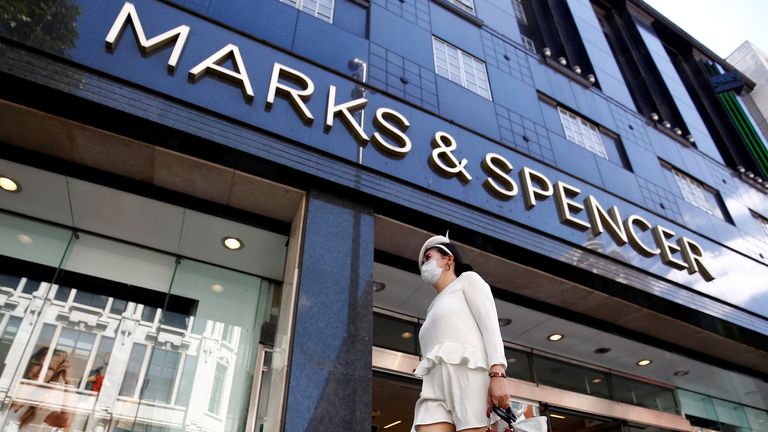Shares in Marks & Spencer have surged after it bumped up its profit outlook following “encouraging” sales – but admitted stores are still struggling to recover after lockdowns.
The retailer pointed to clothing and home sales – increasingly made online – bouncing back to just below pre-pandemic levels as well as a big boost to food revenues as evidence that its turnaround plan was working.
M&S said the trading performance was likely to reflect pent-up demand and cautioned that “substantial uncertainty” over consumer demand remained while supply chain disruption was putting pressure on costs.
Cuts announced at M&S will not be the last“However, assuming no further COVID-related restrictions on trading, at this early stage we expect adjusted profit before tax for the year to be above the upper end of previous guidance of £300-350m,” the retailer said.
Shares rose by as much as 12% following the unscheduled trading update for the 19 weeks to 14 August.
AdvertisementM&S said: “At the start of the year, continued restrictions across large parts of the M&S store portfolio meant that the trading outlook was highly uncertain.
More on Marks And Spencer Marks & Spencer steps up store closures after COVID lockdowns drive it to £201m annual loss Colin v Cuthbert – protecting the brand or a cake-tastrophe? COVID-19: Asda says all its stores will not open on Boxing Day – here are the other retailers staying shut Coronavirus: M&S to cut 950 jobs in shake-up of retail management Coronavirus: M&S to announce hundreds of job cuts this week M&S and Next battle to try on Victoria’s Secret’s UK arm“Since then, M&S has seen an encouraging performance providing confirmation that the transformation programme is on track.”
The profits upgrade provided a rare shaft of optimism for the 137-year-old retailer’s shareholders after years of struggle to arrest its decline and a relegation in 2019 from the FTSE 100.
In its clothing and home division, M&S said it had seen a good recovery with revenue up 92.2% up on a year earlier and just 2.6% below pre-pandemic levels.
Image: M&S said cost-cutting was helping to mitigate the impact of supply chain disruption in its food divisionBut there was a stark divide between the performance of stores – where sales were 19.8% lower than in 2019 reflecting the fact that “many locations remain in slow recovery from the pandemic” – and online – where they were 61.8% higher and now comprise 35% of all clothing and home revenues.
In May, M&S revealed that it was stepping up store closure plans as it reported a £201m pre-tax loss for the year to 27 March as a result of the pandemic.
The latest update showed food sales up by 10.8% on last year and 9.6% ahead of 2019.
M&S said cost-cutting was helping to mitigate the impact of supply chain disruption as well as increased staff absences – without saying whether this was down to self-isolation alerts.
International revenue was up 39.7% on last year and 5.2% down on pre-pandemic levels despite the impact of lockdowns in India and Brexit-related supply disruptions to Ireland and France – the latter an issue recently raised by chairman Archie Norman in a strongly-worded letter to the prime minister.
Earlier this week, M&S revealed that it has made its products available in over 150 countries for the first time via British Corner Shop, an online supermarket for expats.
